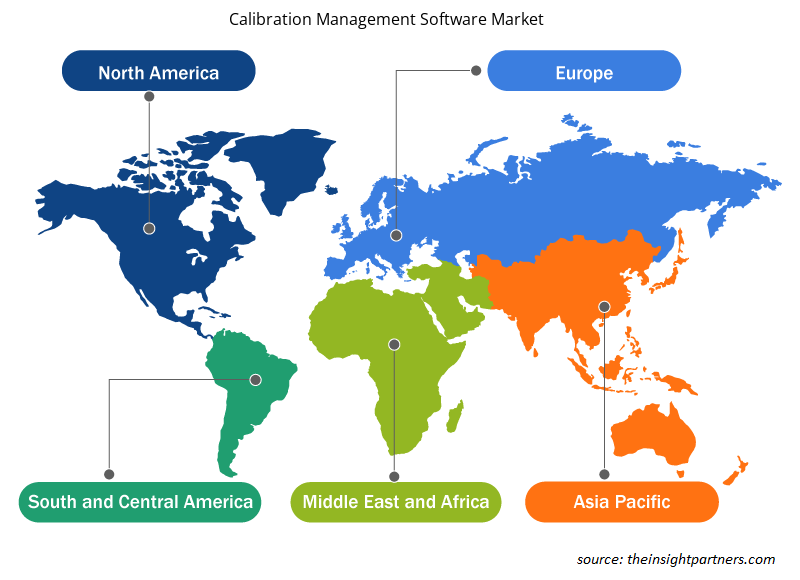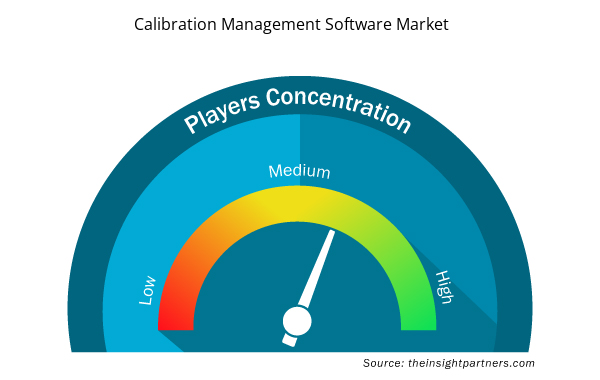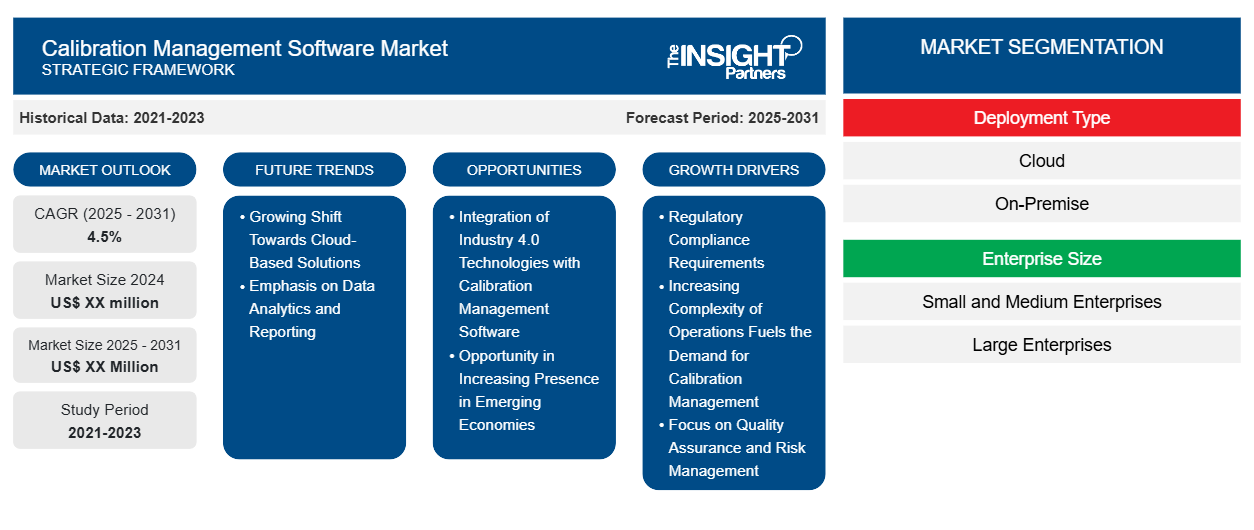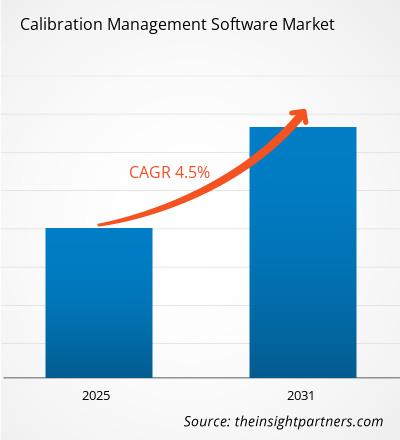Si prevede che il mercato del software di gestione della calibrazione registrerà un CAGR del 4,5% dal 2023 al 2031, con una dimensione di mercato in espansione da XX milioni di dollari nel 2023 a XX milioni di dollari entro il 2031.
Il report è segmentato per tipo di distribuzione (cloud, on-premise); dimensione aziendale (piccole e medie imprese, grandi imprese); settore (petrolio e gas, prodotti farmaceutici, energia ed energia, alimenti e bevande, aerospaziale e difesa, produzione, altri). L'analisi globale è ulteriormente suddivisa a livello regionale e nei principali paesi. Il report offre il valore in USD per l'analisi e i segmenti di cui sopra
Scopo del rapporto
Il report Calibration Management Software Market di The Insight Partners mira a descrivere il panorama attuale e la crescita futura, i principali fattori trainanti, le sfide e le opportunità. Ciò fornirà spunti a vari stakeholder aziendali, come:
- Fornitori/produttori di tecnologia: per comprendere le dinamiche di mercato in evoluzione e conoscere le potenziali opportunità di crescita, consentendo loro di prendere decisioni strategiche informate.
- Investitori: condurre un'analisi completa delle tendenze in merito al tasso di crescita del mercato, alle proiezioni finanziarie del mercato e alle opportunità esistenti lungo la catena del valore.
- Enti di regolamentazione: regolamentano le politiche e le attività di controllo sul mercato allo scopo di ridurre al minimo gli abusi, preservare la fiducia degli investitori e sostenere l'integrità e la stabilità del mercato.
Segmentazione del mercato del software di gestione della calibrazione
Tipo di distribuzione
- Nuvola
- In sede
Dimensioni dell'impresa
- Piccole e Medie Imprese
- Grandi Imprese
Industria
- Petrolio e gas
- Prodotti farmaceutici
- Energia e potenza
- Cibo e bevande
- Aerospaziale e difesa
- Produzione
- Altri
Geografia
- America del Nord
- Europa
- Asia-Pacifico
- America del Sud e Centro
- Medio Oriente e Africa
Geografia
- America del Nord
- Europa
- Asia-Pacifico
- America del Sud e Centro
- Medio Oriente e Africa
Personalizza questo report in base alle tue esigenze
Riceverai la personalizzazione gratuita di qualsiasi report, comprese parti di questo report, o analisi a livello nazionale, pacchetto dati Excel, oltre a usufruire di grandi offerte e sconti per start-up e università
- Scopri le principali tendenze di mercato in questo rapporto.Questo campione GRATUITO includerà analisi di dati che spaziano dalle tendenze di mercato alle stime e alle previsioni.
Driver di crescita del mercato del software di gestione della calibrazione
- Requisiti di conformità normativa: uno dei principali fattori trainanti del mercato del software di gestione della calibrazione è la necessità per le organizzazioni di conformarsi a rigorosi standard normativi in vari settori. Normative come ISO 9001, ISO/IEC 17025 e le linee guida FDA impongono la calibrazione regolare delle apparecchiature di misurazione e collaudo per garantire accuratezza e affidabilità. La mancata conformità può comportare gravi sanzioni e compromettere la qualità del prodotto. Di conseguenza, le aziende stanno adottando sempre più software di gestione della calibrazione per semplificare i processi di conformità, monitorare i programmi di calibrazione e mantenere registrazioni accurate. Questa crescente enfasi sull'aderenza normativa alimenta in modo significativo la domanda di soluzioni di gestione della calibrazione.
- La crescente complessità delle operazioni alimenta la domanda di gestione della calibrazione: la crescente complessità delle operazioni di produzione e di laboratorio richiede una gestione efficace della calibrazione. Man mano che le organizzazioni espandono le loro operazioni e incorporano tecnologie avanzate, aumenta anche il numero di strumenti che richiedono una calibrazione. Questa complessità può portare a sfide nel monitoraggio e nella gestione dei programmi di calibrazione, con conseguenti potenziali tempi di inattività e imprecisioni. Il software di gestione della calibrazione affronta queste sfide automatizzando la pianificazione, il monitoraggio e la reportistica, migliorando così l'efficienza operativa. La necessità di processi semplificati e di una migliore accuratezza in ambienti complessi è un fattore chiave del mercato del software di gestione della calibrazione.
- Concentrazione su garanzia della qualità e gestione del rischio: con una crescente attenzione alla garanzia della qualità e alla gestione del rischio, le organizzazioni stanno dando priorità a processi di misurazione e test accurati. Il software di gestione della calibrazione svolge un ruolo fondamentale nel garantire che strumenti e apparecchiature funzionino correttamente, supportando così le iniziative di garanzia della qualità. Mantenendo registri di calibrazione accurati e facilitando tempestive ricalibrazioni, le organizzazioni possono ridurre al minimo il rischio di errori e garantire l'integrità del prodotto. Questa enfasi sulla qualità e sulla mitigazione del rischio sta guidando l'adozione di software di gestione della calibrazione in vari settori, tra cui produzione, assistenza sanitaria e farmaceutica.
Tendenze future del mercato del software di gestione della calibrazione
- Crescente spostamento verso soluzioni basate su cloud: una tendenza degna di nota nel mercato del software di gestione della calibrazione è lo spostamento verso soluzioni basate su cloud. Le organizzazioni stanno adottando sempre più la tecnologia cloud per la sua scalabilità, accessibilità ed economicità. Il software di gestione della calibrazione basato su cloud consente agli utenti di accedere ai dati e gestire le calibrazioni da qualsiasi luogo, facilitando la collaborazione tra team e migliorando la sicurezza dei dati. Inoltre, le soluzioni cloud spesso sono dotate di aggiornamenti e manutenzione automatici, riducendo l'onere sulle risorse IT. Poiché le aziende danno priorità alla flessibilità e all'accesso remoto, si prevede che la domanda di soluzioni di gestione della calibrazione basate su cloud crescerà.
- Enfasi su analisi dei dati e reporting: la crescente enfasi sul processo decisionale basato sui dati sta plasmando il mercato del software di gestione della calibrazione. Le organizzazioni sono alla ricerca di soluzioni che non solo gestiscano i programmi di calibrazione, ma forniscano anche capacità di analisi e reporting avanzate. Questa tendenza consente alle aziende di ottenere informazioni sulle prestazioni di calibrazione, identificare tendenze e ottimizzare i processi. Sfruttando l'analisi dei dati, le organizzazioni possono prendere decisioni informate in merito alla manutenzione delle apparecchiature e all'allocazione delle risorse, migliorando in definitiva l'efficienza operativa. La domanda di software di gestione della calibrazione dotato di solide funzionalità di analisi dei dati è in aumento poiché le aziende si sforzano di migliorare i propri sistemi di gestione della qualità complessivi.
Opportunità di mercato per il software di gestione della calibrazione
- Integrazione delle tecnologie Industry 4.0 con il software di gestione della calibrazione: l'ascesa di Industry 4.0 e dell'Internet of Things (IoT) presenta opportunità significative per i fornitori di software di gestione della calibrazione. Man mano che sempre più produttori adottano tecnologie intelligenti, aumenta la domanda di sistemi integrati in grado di comunicare e condividere dati senza soluzione di continuità. Il software di gestione della calibrazione che può integrarsi con dispositivi IoT e altri strumenti digitali migliorerà l'accuratezza dei dati e consentirà il monitoraggio in tempo reale delle prestazioni delle apparecchiature. Questa integrazione può portare a manutenzione predittiva, riduzione dei tempi di fermo e miglioramento dell'efficienza operativa. Man mano che le industrie continuano ad abbracciare la trasformazione digitale, il potenziale per soluzioni di calibrazione innovative è vasto.
- Opportunità di una presenza crescente nelle economie emergenti: c'è una crescente opportunità per i fornitori di software di gestione della calibrazione di espandersi nei mercati emergenti in cui l'industrializzazione e i quadri normativi si stanno evolvendo. I paesi dell'Asia-Pacifico, dell'America Latina e dell'Africa stanno vivendo una rapida crescita nei servizi di produzione e di laboratorio, portando a una maggiore necessità di una gestione efficace della calibrazione. Con lo sviluppo di questi mercati, le aziende locali cercheranno soluzioni per garantire la conformità agli standard internazionali e migliorare l'efficienza operativa. Adattando le offerte per soddisfare le esigenze specifiche di queste economie emergenti, i fornitori di software possono capitalizzare sul mercato in espansione e stabilire una solida base.
Approfondimenti regionali sul mercato del software di gestione della calibrazione
Le tendenze regionali e i fattori che influenzano il mercato del software di gestione della calibrazione durante il periodo di previsione sono stati ampiamente spiegati dagli analisti di Insight Partners. Questa sezione discute anche i segmenti e la geografia del mercato del software di gestione della calibrazione in Nord America, Europa, Asia Pacifico, Medio Oriente e Africa e America meridionale e centrale.

- Ottieni i dati specifici regionali per il mercato del software di gestione della calibrazione
Ambito del rapporto di mercato sul software di gestione della calibrazione
| Attributo del report | Dettagli |
|---|---|
| Dimensioni del mercato nel 2023 | XX milioni di dollari USA |
| Dimensioni del mercato entro il 2031 | XX milioni di dollari USA |
| CAGR globale (2023-2031) | 4,5% |
| Dati storici | 2021-2022 |
| Periodo di previsione | 2024-2031 |
| Segmenti coperti | Per tipo di distribuzione
|
| Regioni e Paesi coperti | America del Nord
|
| Leader di mercato e profili aziendali chiave |
|
Densità dei player del mercato del software di gestione della calibrazione: comprendere il suo impatto sulle dinamiche aziendali
Il mercato del software di gestione della calibrazione sta crescendo rapidamente, spinto dalla crescente domanda degli utenti finali dovuta a fattori quali l'evoluzione delle preferenze dei consumatori, i progressi tecnologici e una maggiore consapevolezza dei vantaggi del prodotto. Con l'aumento della domanda, le aziende stanno ampliando le loro offerte, innovando per soddisfare le esigenze dei consumatori e capitalizzando sulle tendenze emergenti, il che alimenta ulteriormente la crescita del mercato.
La densità degli operatori di mercato si riferisce alla distribuzione di aziende o società che operano in un particolare mercato o settore. Indica quanti concorrenti (operatori di mercato) sono presenti in un dato spazio di mercato in relazione alle sue dimensioni o al valore di mercato totale.
Le principali aziende che operano nel mercato del software di gestione della calibrazione sono:
- Azienda Baker Hughes
- Beamex Oy Ab
- Soluzioni di calibrazione CompuCal
- CORPORAZIONE DI CIBERMETRIA
- Società Fluke
- Società a responsabilità limitata
Disclaimer : le aziende elencate sopra non sono classificate secondo un ordine particolare.

- Ottieni la panoramica dei principali attori del mercato del software di gestione della calibrazione
Punti di forza chiave
- Copertura completa: il rapporto copre in modo completo l'analisi di prodotti, servizi, tipologie e utenti finali del mercato del software di gestione della calibrazione, fornendo una panoramica olistica.
- Analisi degli esperti: il rapporto è compilato sulla base della conoscenza approfondita di esperti e analisti del settore.
- Informazioni aggiornate: il rapporto garantisce la pertinenza aziendale grazie alla copertura di informazioni recenti e tendenze nei dati.
- Opzioni di personalizzazione: questo report può essere personalizzato per soddisfare le esigenze specifiche del cliente e adattarsi in modo appropriato alle strategie aziendali.
Il rapporto di ricerca sul mercato del software di gestione della calibrazione può quindi aiutare a guidare il percorso di decodifica e comprensione dello scenario del settore e delle prospettive di crescita. Sebbene possano esserci alcune preoccupazioni valide, i vantaggi complessivi di questo rapporto tendono a superare gli svantaggi.
- Analisi storica (2 anni), anno base, previsione (7 anni) con CAGR
- Analisi PEST e SWOT
- Valore/volume delle dimensioni del mercato - Globale, regionale, nazionale
- Industria e panorama competitivo
- Set di dati Excel



Report Coverage
Revenue forecast, Company Analysis, Industry landscape, Growth factors, and Trends

Segment Covered
This text is related
to segments covered.

Regional Scope
North America, Europe, Asia Pacific, Middle East & Africa, South & Central America

Country Scope
This text is related
to country scope.
Domande frequenti
The report can be delivered in PDF/PPT format; we can also share excel dataset based on the request
Some of the customization options available based on the request are an additional 3-5 company profiles and country-specific analysis of 3-5 countries of your choice. Customizations are to be requested/discussed before making final order confirmation# as our team would review the same and check the feasibility
The Calibration Management Software Market is estimated to witness a CAGR of 4.5% from 2023 to 2031
Cloud-based solutions to play a significant role in the global calibration management software market in the coming years
Stringent quality standards and need for operational efficiency are the major factors driving the calibration management software market
Trends and growth analysis reports related to Technology, Media and Telecommunications : READ MORE..
The List of Companies
1. Baker Hughes Company
2. Beamex Oy Ab
3. CompuCal Calibration Solutions
4. CYBERMETRICS CORPORATION
5. Fluke Corporation
6. MasterControl, Inc.
7. Prime Technologies
8. Productivity-Quality Systems, Inc.
9. Qualer
10. Verse Solutions
The Insight Partners performs research in 4 major stages: Data Collection & Secondary Research, Primary Research, Data Analysis and Data Triangulation & Final Review.
- Data Collection and Secondary Research:
As a market research and consulting firm operating from a decade, we have published and advised several client across the globe. First step for any study will start with an assessment of currently available data and insights from existing reports. Further, historical and current market information is collected from Investor Presentations, Annual Reports, SEC Filings, etc., and other information related to company’s performance and market positioning are gathered from Paid Databases (Factiva, Hoovers, and Reuters) and various other publications available in public domain.
Several associations trade associates, technical forums, institutes, societies and organization are accessed to gain technical as well as market related insights through their publications such as research papers, blogs and press releases related to the studies are referred to get cues about the market. Further, white papers, journals, magazines, and other news articles published in last 3 years are scrutinized and analyzed to understand the current market trends.
- Primary Research:
The primarily interview analysis comprise of data obtained from industry participants interview and answers to survey questions gathered by in-house primary team.
For primary research, interviews are conducted with industry experts/CEOs/Marketing Managers/VPs/Subject Matter Experts from both demand and supply side to get a 360-degree view of the market. The primary team conducts several interviews based on the complexity of the markets to understand the various market trends and dynamics which makes research more credible and precise.
A typical research interview fulfils the following functions:
- Provides first-hand information on the market size, market trends, growth trends, competitive landscape, and outlook
- Validates and strengthens in-house secondary research findings
- Develops the analysis team’s expertise and market understanding
Primary research involves email interactions and telephone interviews for each market, category, segment, and sub-segment across geographies. The participants who typically take part in such a process include, but are not limited to:
- Industry participants: VPs, business development managers, market intelligence managers and national sales managers
- Outside experts: Valuation experts, research analysts and key opinion leaders specializing in the electronics and semiconductor industry.
Below is the breakup of our primary respondents by company, designation, and region:

Once we receive the confirmation from primary research sources or primary respondents, we finalize the base year market estimation and forecast the data as per the macroeconomic and microeconomic factors assessed during data collection.
- Data Analysis:
Once data is validated through both secondary as well as primary respondents, we finalize the market estimations by hypothesis formulation and factor analysis at regional and country level.
- Macro-Economic Factor Analysis:
We analyse macroeconomic indicators such the gross domestic product (GDP), increase in the demand for goods and services across industries, technological advancement, regional economic growth, governmental policies, the influence of COVID-19, PEST analysis, and other aspects. This analysis aids in setting benchmarks for various nations/regions and approximating market splits. Additionally, the general trend of the aforementioned components aid in determining the market's development possibilities.
- Country Level Data:
Various factors that are especially aligned to the country are taken into account to determine the market size for a certain area and country, including the presence of vendors, such as headquarters and offices, the country's GDP, demand patterns, and industry growth. To comprehend the market dynamics for the nation, a number of growth variables, inhibitors, application areas, and current market trends are researched. The aforementioned elements aid in determining the country's overall market's growth potential.
- Company Profile:
The “Table of Contents” is formulated by listing and analyzing more than 25 - 30 companies operating in the market ecosystem across geographies. However, we profile only 10 companies as a standard practice in our syndicate reports. These 10 companies comprise leading, emerging, and regional players. Nonetheless, our analysis is not restricted to the 10 listed companies, we also analyze other companies present in the market to develop a holistic view and understand the prevailing trends. The “Company Profiles” section in the report covers key facts, business description, products & services, financial information, SWOT analysis, and key developments. The financial information presented is extracted from the annual reports and official documents of the publicly listed companies. Upon collecting the information for the sections of respective companies, we verify them via various primary sources and then compile the data in respective company profiles. The company level information helps us in deriving the base number as well as in forecasting the market size.
- Developing Base Number:
Aggregation of sales statistics (2020-2022) and macro-economic factor, and other secondary and primary research insights are utilized to arrive at base number and related market shares for 2022. The data gaps are identified in this step and relevant market data is analyzed, collected from paid primary interviews or databases. On finalizing the base year market size, forecasts are developed on the basis of macro-economic, industry and market growth factors and company level analysis.
- Data Triangulation and Final Review:
The market findings and base year market size calculations are validated from supply as well as demand side. Demand side validations are based on macro-economic factor analysis and benchmarks for respective regions and countries. In case of supply side validations, revenues of major companies are estimated (in case not available) based on industry benchmark, approximate number of employees, product portfolio, and primary interviews revenues are gathered. Further revenue from target product/service segment is assessed to avoid overshooting of market statistics. In case of heavy deviations between supply and demand side values, all thes steps are repeated to achieve synchronization.
We follow an iterative model, wherein we share our research findings with Subject Matter Experts (SME’s) and Key Opinion Leaders (KOLs) until consensus view of the market is not formulated – this model negates any drastic deviation in the opinions of experts. Only validated and universally acceptable research findings are quoted in our reports.
We have important check points that we use to validate our research findings – which we call – data triangulation, where we validate the information, we generate from secondary sources with primary interviews and then we re-validate with our internal data bases and Subject matter experts. This comprehensive model enables us to deliver high quality, reliable data in shortest possible time.


 Ottieni un campione gratuito per questo repot
Ottieni un campione gratuito per questo repot